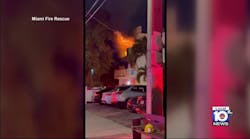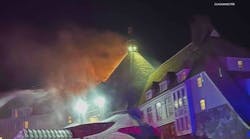The rampant demolition of historic buildings in the United States from the 1950s through the 1970s largely bypassed Bellefonte, PA, leaving many large historically and architecturally significant commercial and residential buildings untouched. This has now become a fire problem for Bellefonte. For instance, on Feb. 8, 2006, a three-alarm fire destroyed a 138-year-old historic downtown hotel. This was the second fire in 18 months to destroy a historic building in Bellefonte - on July 14, 2004, the 119-year-old Bellefonte Academy was destroyed by fire. Both buildings were listed on the National Register of Historic Places. Last month, fire destroyed a third building in the historic district (see page 57). The fires and their impact on the local fire department and the community offer a case study in managing fire risk in historic structures.
The four-story hotel was built by Daniel Bush in 1868. In its day, the Bush House "ranked as one of the most perfectly appointed and commodious hotels in central Pennsylvania." The hotel hosted such legendary Americans as Amelia Earhart, Thomas Edison, Henry Ford and Charles Lindbergh. Constructed of ordinary material with brick walls, four to six courses thick, the building had a wooden roof covered with an asphalt shingles and metal roofing. The building occupied a footprint of 15,000 square feet. Fire protection systems in the building included a manual-pull station fire alarm that was not tied to a central system and a limited-area sprinkler system in the central stairway that also was not tied to an alarm system. At the time of the fire, the building contained two restaurants, a tavern, several business offices, banquet facilities, hotel rooms and an innkeeper's suite. There were no rooms rented and the innkeeper was staying elsewhere.
The Bellefonte Fire Department, consisting of the Logan Fire Company and Undine Fire Company, was dispatched for "reported smoke coming from the roof" of the Bush House at 315 W. High St. at 6:57 A.M. Mount Nittany Medical Center Paramedic Matt Boone, returning from a call, was stopped at the intersection of High and Water streets and immediately informed the Centre County Emergency Communications Center of heavy smoke issuing from the fourth floor. The sun was just beginning to rise, making the smoke visible. Soon after dispatch, communications advised that multiple calls were being received reporting the fire.
Responding on the initial alarm were Bellefonte Engine 1-11 with a crew of four, Engine 2-12 with a crew of six, Truck 2-17 with a crew of five and Rescue 1-14 with a crew of five. Bellefonte Deputy Fire Chief (and Logan Fire Chief) Jim Beaver arrived on scene at 6:59 and observed heavy smoke showing and immediately requested a second alarm. Beaver established command on side A of the building. Bellefonte Fire Chief Tim Knisely arrived on side C and reported heavy smoke conditions at the rear of the building in the area of the dining room and established the rear sector.
Truck 2-17 was first to arrive and positioned on side A and the crew forced entry to the main lobby of the hotel. Firefighters encountered heavy smoke and heat, but no visible fire as they began a primary search. Engine 1-11 was next to arrive and laid 100 feet of five-inch supply line from a hydrant at the intersection of High and Water streets to a position in front of the building. The crew from this engine forced entry into a business office on side A and advanced a 200-foot 1¾-inch attack line into the office area. Firefighters encountered heavy smoke and heat, but found no fire until the drop ceiling was pulled. Heavy fire was found in the ceiling and suppression efforts were initiated in this area.
The rear sector reported heavy fire on the first floor and that a rear exit door was almost completely burned with fire venting up the exterior, exposing the second and third floors. Engine 2-12 was next arriving and laid a 250-foot five-inch supply line from a hydrant on Dunlop Street to a parking lot on side C. The crew from Truck 2-17 exited the rear of the building and assisted the crew of Engine 2-12 in advancing a 200-foot 1¾-inch attack line to the rear door that had burned off and a 200-foot 2½-inch attack line with a step gun to the roof of the one-story dining room in an attempt to slow the fire's vertical spread. Rescue 1-14 was staged on High Street and its crew reported to command and assisted with the suppression effort.
Responding on the second alarm were Bellefonte Engine 2-10, Engine-Rescue 9-14 from Citizen's Hook & Ladder in Milesburg, Engine 8-10 from the Pleasant Gap Fire Department, Engine 16-12 from the Walker Township Fire Department, Truck 5-17 from the Alpha Fire Company in State College and Truck 12-16 from the Phillipsburg Fire Department in place of Bellefonte Truck 2-16, which was out of service.
Engine 2-10 was positioned on West High Street at the A-D corner and hooked onto a hydrant at the intersection of High and Water streets with a 100-foot five-inch line to supply Truck 2-17 with a 200-foot five-inch line. Engine 2-10 later used its deck gun during defensive operations. Engine 9-14 laid a 300-foot five-inch supply line from a hydrant on South Potter Street to the A-B corner of the building. The crew from this engine advanced two 1¾-inch attack lines into the storefronts at the A-B corner. Engine 8-10 was positioned next to the B exposure, a one-story historic market 16 feet from the fire building. This engine drafted from a race that ran under the exposure building with 20 feet of six-inch hard suction and operated its deck gun and step gun for fire attack and exposure protection.
Engine 16-10 was staged on the 200 block of West High Street and its crew was assigned to side A to assist with interior operations. This engine later laid a 600-foot five-inch supply line from Engine 9-14 to Spring Creek and drafted with 20 feet of hard suction to replace the hydrant supply Engine 9-14 was using. Truck 5-17 was set up at the A-B corner and prepared for defensive operations. This truck was supplied with a 100-foot five-inch line from Engine 9-14. Truck 12-16 was set up on side C for defensive operations and supplied by Rescue 1-14. Rescue 1-14 laid a 200-foot five-inch supply line from Truck 12-16 to a race on Dunlop Street and drafted with 20 feet of six-inch hard suction.
At 7:30 A.M., command ordered all firefighters to evacuate the building due to deteriorating conditions and rapid fire spread. All interior firefighters were accounted for and handlines and ground monitors were set up on the perimeter of the building. To supplement the water supply, Engine 5-11 from the Alpha Fire Company, Engine 3-11 from the Boalsburg Fire Company and Clinton County Engine 9-2 from the Beech-Creek/Blanchard Fire Company, initially on transfer to Milesburg, were special-called. Also special-called was Mifflin County Rehab 12-1 from the Fame Emergency Medical Services of Lewistown to establish a long-duration firefighter rehab area.
As the fire continued to spread, command recognized that the potential for building collapse was imminent. The first-arriving apparatus needed to be repositioned out of the collapse zone, but freezing road surfaces made this a slow task. The Bellefonte Borough Public Works and the Pennsylvania Department of Transportation provided salt and anti-skid materials to allow the apparatus to move. Eventually, apparatus and hoselines were moved before the collapse occurred. Engine 5-113 laid a 600-foot five-inch supply line from Engine 1-11 to Spring Creek and drafted with 20 feet of six-inch hard suction. Due to a pump problem on Engine 5-113, Engine 3-11 resumed the drafting operation.
Throughout the morning, the fire continued to spread through the remainder of the building. More than 75% of the building collapsed and heavy equipment was called to demolish a few remaining walls to prevent a later collapse onto the street or into the stream. The fire was brought under control by 4 P.M. Most mutual aid departments were released by 5 P.M., but Bellefonte and State College crews remained on the scene until midnight extinguishing hot spots and assisting the demolition crew. There was minimal damage to the building on exposure A. No other buildings suffered any damage. There were no injuries to firefighters or civilians.
One hundred twenty-five firefighters operated at the scene using 10 engines, three aerial devices, one rescue squad, one rehab unit and three EMS units. A five-day investigation was conducted by fire marshals from the Pennsylvania State Police and members of the Bellefonte Fire Department. The cause of the fire was undetermined due to the amount of damage and the structural collapse. Damage was estimated at $2 million to the building and $1 million to the contents.
After this second major fire in a historic building in Bellefonte in 18 months, the borough council asked the fire department for guidance in protecting the historic buildings. Bellefonte Borough has 368 buildings on the National Register of Historic Places, along with many other older homes and buildings of local historic value. Knisely selected a group of subject-matter experts to evaluate the fire problem in Bellefonte and make recommendations for the council to consider for the protection of these buildings. The Historic Preservation and Fire Prevention Task Force was made up of a fire protection engineer, structural engineer, code development specialist, historic preservation specialist, fire alarm contractor, fire sprinkler contractor, the borough's safety committee chairman and Knisely. The task force held its first meeting on March 8, 2006.
Among the first decisions of the task force was to make efforts to educate the community on the fire problem, since most property owners and elected officials do not have a good understanding or basic knowledge of fire prevention. The task force secured a grant from the Pennsylvania Historic and Museum Commission to present an educational program for the community. Fire Protection Engineer Nick Artim of the Fire Safety Network in Middlebury, VT, presented a program entitled "The Philosophy of Fire" to about 50 citizens and business owners in the community as well as other government and fire officials from across Pennsylvania.
Next, the task force examined the borough codes that were in place and what codes were available that could be implemented to address the historic buildings. Currently, there is a public housing code that regulates rental properties, but it had not been updated in over 20 years. The Pennsylvania state building code includes an existing building code, but it is applicable only when a building undergoes a renovation.
On March 19, 2007, the final report was presented to the borough council by task force members. A list of six recommendations was presented to the borough council on March 19, 2007, by Dennis Gentzel, chief fire protection engineer for the Maryland State Fire Marshal. This report featured consideration for a total fire prevention protection program including, but not limited to, a regular fire inspection program for all commercial buildings; replacing the public housing code with a model code, such as the International Property Maintenance Code and the International Fire Code; and use of National Fire Protection Association (NFPA) Standard 914, Fire Protection of Historic Structures.
It was recommended to the council that consideration be given to the retrofitting buildings with fire alarm systems, sprinkler systems and other suppression systems, depending on the risk. It is critically important that these systems be designed, installed and maintained in accordance with the recommended NFPA standards. This will require strict code enforcement by borough officials and the fire department. If the systems are installed inadequately or not properly designed, the system may fail to operate properly or cause unwanted system activations and responses. The council was also encouraged to provide financial incentives for building owners to offset their investment.
These recommendations, if undertaken, could reduce the risk of fire and improve the safety to the occupants and the firefighters. Council members are currently reviewing the report to determine what recommendations can be feasibly implemented. Concern has been expressed over the costs that will be associated with the improvements. Nearly 120 years ago, a similar report was delivered to the Borough Council in response to fires that had occurred in town. In 1888, a committee was appointed to visit Bellefonte and it presented a paper to the council listing several ways to prevent fire losses. It recommended the appointment of a fire marshal to inspect all buildings in the borough, including the condition of stove pipes, heaters, flues, ash receptacles, rubbish in cellars and attics and other unsafe features. The report also recommended the construction of fire walls between buildings. The current council was reminded that it cannot wait another 119 years to take action.
Even though Bellefonte lost two buildings that were important parts of history to fire, it was lucky that no one was seriously injured or killed in either fire. Knisely stated, "The only way to preserve the historic fabric of old towns throughout Pennsylvania and across the country is through modern and proven fire protection efforts."
BELLEFONTE FIRE DEPARTMENT PROFILE
Chief Fred Bruno Personnel: 70 volunteer firefighters Apparatus: Three pumpers, two aerials, one rescue engine, one tanker, two brush rigs, one utility vehicle, one chief's car Population: 12,000 Area: 42 square milesJAY K. BRADISH/IFPA, Firehouse news editor, is a former captain in the Bradford Township, PA, Fire Department. He has been a volunteer firefighter and fire photographer for more than 25 years.





